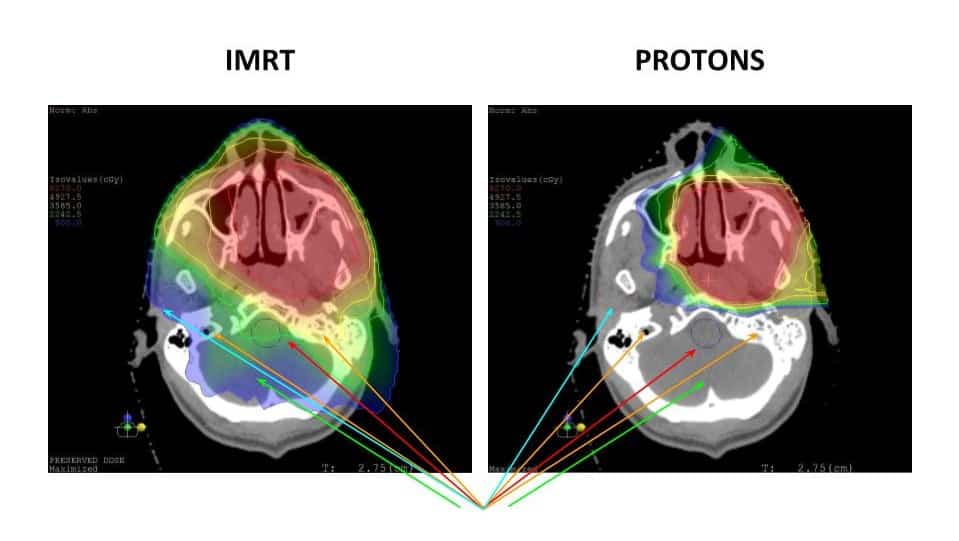
Head and Neck Cancer Proton Therapy – A dramatic difference for some cases.
DISCLAIMER / About the Blog – Please read once if you haven’t.
For Part 1 of this Head and Neck example, please look here.
In Part 2, we’ll move a little higher and look at dose to a few more structures and compare differences between plans. So in the image below, we are a little higher in the head – the nose is at the top of the image and the ears are visible on the left and right.
Precision of Proton Therapy
Orientation: Below is a CT scan – slices are, if you are standing up, from front to back of head. You see the nose at the “top” and ears on the “sides”. The color overlays are dose (RED is the most radiation and then orange, then yellow, then green, then lowest is blue). The arrows point to important structures we’ll review below.
As you can clearly see, the Proton Therapy plan is far more targeted and precise. The region at risk for tumor (the red region) similar but the Proton Therapy plan is more targeted and doesn’t “leak” out high dose to nose or cheek / parotid region near the target. Target wise, in this part of the plan the high dose volume wins and wins pretty easily from my physician standpoint.
Mid and Low Dose Regions
Next, let’s look some mid and low dose regions of the plan. The GREEN and RED regions are basically brain tissue. There is essentially zero chance of cancer here and every radiation oncologist would try to limit dose to these structures. There is no reason to radiate healthy brain when it’s not at risk. The external beam unfortunately delivers significant mid level doses to the brain and brainstem. Just to be clear, these dose levels do NOT put you risk for permanent brainstem damage (which can result in loss of nerve function or death). But it can’t be good. It has to be worse for you – has to be. I’d bet that 5-10 years out this person would have significantly more subtle changes that quicken the aging process.
For example, as just about everyone ages, at some point most struggle to walk and get around without some assistance. This extra radiation HAS to speed the quickness with which patients struggle to walk at some point in the future – my best clinical guess would 2-5 years quicker for patients post-treatment as they reach their 70s. << That’s a guess. (A ballpark clinical guess – there is no data where this is measured – I can’t point to a trial and say “here” – but radiation to the brain isn’t needed and can’t be good – today’s reality is there is little long-term side effect high level data after cancer treatment comparing various treatments).
Effect on Nearby Parotid Gland
Next, look at the BLUE /CYAN arrow which points to the opposite unrelated parotid gland. Giving less dose to the parotids is one of the main advantages of IMRT vs. 3D (3D plan not shown). IMRT replaced 3D treatment due to reduced dose to this structure as one of the primary improvements. Treatment of the parotid is related to taste, tolerance of treatment, long-term salivary function, dental health, and risk of damage to the mandible. There is no comparison between IMRT and Proton Therapy plan. The Proton radiation plan is far, far better, essentially removing all radiation dose from the opposite parotid salivary gland in this case.
Effect on Hearing
Finally, we’ll look at the two ORANGE arrows which point to the approximate region of the middle ear. Radiation oncologists have started looking at these structures in the last decade or so to help improve long-term hearing by reducing dose to these sensitive structures. Like the opposite parotid, there is no comparison between the two plans. The Proton radiation plan is far superior. The IMRT plan will cause long-term hearing loss to some degree. Radiation is not good for the small bones and sensitive structures of the middle ear required for hearing. The Proton plan essentially removes dose from both of these normal structures.
Protons aren’t a magic fix all answer. But for some cases and for some patients, Proton Therapy can dramatically improve your treatment plan.
If you have been diagnosed with a head and neck cancer and would us to run a quick example plan of how protons might help limit side effects and improve outcomes for your case, please contact us today. If you are at a center that doesn’t have Proton Therapy – you can ask for a comparison plan but I can almost guarantee they can’t run a comparison – you have to get to a Proton center and get the comparison there.
Dr. Mark Storey MD
Medical Director, Oklahoma Proton Center
